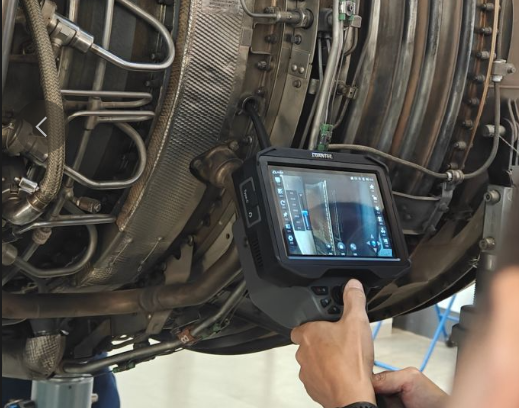
In today’s fast-paced industries, inspection tools play a critical role in ensuring safety, efficiency, and reliability. Among these, the industrial endoscope has become one of the most valuable devices for engineers, technicians, and maintenance teams.
An industrial endoscope allows professionals to look inside confined, complex, and hard-to-reach spaces without dismantling equipment. It provides real-time visuals that help identify wear, corrosion, leaks, or defects before they escalate into costly failures.
From automotive workshops to aerospace facilities and manufacturing plants, the industrial endoscope is transforming how inspections and preventive maintenance are carried out.
What is an Industrial Endoscope?
An industrial endoscope is a flexible or rigid inspection camera designed to navigate narrow pathways and capture images or videos inside machinery, pipelines, and structures. It usually consists of:
A flexible insertion tube or probe
A camera with LED lighting
A display screen for real-time viewing
Recording capabilities for documentation
This tool is sometimes also called a borescope or videoscope, though industrial-grade endoscopes usually provide higher resolution and more advanced features.
Why Use an Industrial Endoscope?
1. Non-destructive Testing (NDT)
Inspect internal components without cutting, drilling, or dismantling equipment.
2. Cost and Time Savings
Reduce downtime by performing inspections quickly and efficiently.
3. Enhanced Safety
Check for potential hazards in dangerous or confined spaces.
4. Accurate Diagnostics
High-resolution imaging makes it easier to detect even micro-cracks, blockages, or corrosion.
Applications of Industrial Endoscopes
Industrial endoscopes are versatile and widely used across multiple sectors:
Automotive Industry
Inspecting engine cylinders, pistons, and valves
Detecting carbon buildup or turbocharger issues
Ensuring quality control during assembly
Aerospace Industry
Examining aircraft turbines and engine components
Detecting micro-cracks or material fatigue
Complying with strict aviation safety standards
Oil, Gas, and Energy
Inspecting pipelines for corrosion or leaks
Monitoring pressure vessels and boilers
Maintaining power plant turbines
Manufacturing and Industrial Equipment
Checking welds for structural integrity
Examining gearboxes, pumps, and compressors
Ensuring machinery is free of debris or defects
Construction and Infrastructure
Inspecting conduits, walls, and drainage systems
Evaluating bridge joints and structural reinforcements
Detecting water leaks in hidden areas
Benefits of Industrial Endoscope
High-resolution imaging for better accuracy
Portable design for field inspections
Video recording for documentation and analysis
Flexible probes that navigate tight spaces
Durability for industrial-grade applications
Types of Industrial Endoscopes
Rigid Endoscopes
Strong and durable
Ideal for straight-path inspections
Flexible Endoscopes
Can bend to navigate complex engine or pipe layouts
Widely used in automotive and aerospace industries
Video Endoscopes (Videoscopes)
Equipped with digital cameras and recording functions
Offer higher resolution and real-time playback
Wireless Endoscopes
Connect to smartphones, tablets, or computers
Convenient for mobile and remote inspections
How to Choose the Right Industrial Endoscope
When selecting an industrial endoscope, consider:
Probe length and diameter – must fit the inspection area
Camera resolution – HD or 4K ensures detailed imaging
Lighting system – adjustable LEDs for dark spaces
Durability – oil-resistant, waterproof, and shockproof design
Recording and storage – SD card, USB, or cloud support
Battery life – essential for extended inspections
Industrial Endoscope vs. Medical Endoscope
Though both share similar principles, industrial endoscopes differ from medical endoscopes in design and application:
Industrial versions are rugged, waterproof, and resistant to oil industrial endoscope and dust.
They often include longer probes and higher durability for harsh conditions.
Medical endoscopes focus on delicate precision and sterilization standards.
The Future of Industrial Endoscope Technology
Technology is rapidly evolving in this field, and we can expect:
AI-powered defect detection for automated analysis
Wireless 5G streaming for remote collaboration
Micro-sized probes for even smaller inspection channels
Augmented Reality (AR) integration to guide technicians
Maintenance Tips for Industrial Endoscopes
Clean the probe after each use.
Avoid excessive bending to prevent damage.
Store in a protective case.
Keep batteries charged.
Regularly check for firmware or software updates.
Conclusion
The industrial endoscope has become an indispensable tool in modern industries. With its ability to provide real-time visuals of hard-to-reach areas, it helps technicians perform inspections more effectively, reduce downtime, and improve safety.
Whether in automotive repair, aerospace maintenance, oil & gas pipelines, or manufacturing equipment, the industrial endoscope proves to be an invaluable asset for preventive maintenance and diagnostics.
By investing in the right model and applying proper care, companies can save significant time and resources while ensuring the highest operational standards.